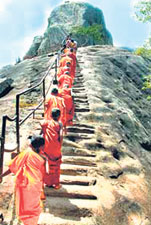On the full moon day in the month of May/June – traditionally known as Poson – in 247 B.C.,
a person dressed in a
yellow robe appears on top of Ambastala in the Missaka mountain at Mihintale –11 kilometres north-east of Anuradhapura, the capital city. There are four others with him.
The country's ruler is on a hunting trip with his entourage. With bow and arrow in hand he is seen near a mango tree. The sage who appears on the hilltop addresses him by his name, “Tissa.” He is bewildered. “How dare he address me by my name,” he thinks. Yet he moves forward.
That is how Arahant Mahinda, the son of King Dharmasoka from India met King Devanampiya Tissa. Arahant Mahinda was here to introduce Buddhism. However, he had to make sure that the king and the people would be able to understand the doctrine of the Buddha.
He tested the king by asking him a few simple questions.
Pointing to the mango tree, he asked "What name does this tree bear, O King?"
"This tree is called a mango", the king answered.
"Is there yet another mango beside this?"
"There are many mango trees."
"Are there yet other trees besides this mango and other mango trees?"
"There are many other trees but they are not
mangoes"
"Beside the other mango trees and those which are not mangoes, are there any other trees?"
"Yes – there is this mango tree".
The sage was satisfied. The dialogue was over.
Some call this
conversation the first recorded intelligence test in history.
The exact spot where the king stood as the
conversation took place is still visible. It is covered with a stone slab,
popularly known as
'candrakanti paashana'.
Arahant Mahinda then preached the first sermon describing the essence of Buddhism in a
nutshell after which the king and his entourage embraced Buddhism.
Having spent the first day in Mihintale, Arahant Mahinda moved to the city on the king's invitation. The Mahamegha gardens – now referred to as Mahamevuna Uyana – was given over to him and the great numbers who entered the Order of the Maha Sangha. When the royal park was granted to the Sangha, the
consecrated
boundaries were fixed by the king himself ploughing a furrow to mark them so as to include the city within them.
Thus was
established the Mahavihara which became a celebrated centre of the Buddhist religion.
During the rainy season (vassana) Arahant Mahinda and his disciples spent the retreat in the caves built for them in Mihintale.
The 'Mihindu guhava' – the cave where he rested is still well preserved and is a popular place of worship.
The king built the Thuparama Dagoba for the devotees to worship. This is the first stupa to be erected in Anuradhapura. The
collar bone of the Buddha is enshrined in it.
Mihintale is impressive as the centre of the cradle of Sinhala Buddhist
civilization. The broad stone steps – 1840 in
number – provide the
devotees with a leisurely climb under the shade of 'araliya' trees.
The climb to the Aradhana gala – the peak where Arahant Mahinda was first spotted, is an exciting one. The view from the top is fascinating. Dagobas like the Maha Seya, Indikatu Seya, Cetiya Pabbata and the Kantaka Cetiya are
symbols of Buddhist
architecture.
The Kantaka Cetiya has earned a
reputation for the intricate 'vahalkadas' or
frontispieces which
demonstrate the Sinhala sculptor's clever hand. There are many more
intricate architectural
features in the Kantaka Cetiya.
Apart from the cetiyas, Mihintale boasts of
monastic residences, lakes where the monks bathed and where water was stored, and other facilities which are a hallmark of a rich civilization.
For the Buddhists in
Sri Lanka, Poson Poya is only second to Vesak. While the latter celebrates the Birth, Enlightenment and the Passing Away of Lord Buddha, Poson marks the introduction of Buddhism to Sri Lanka by Arahant Mahinda.
Pilgrims in their
thousands flock to Anuradhapura and Mihintale where they will visit the sacred places of
worship and commemorate an event of great
significance since it also marks the beginning of Sri Lanka's great civilization. |


